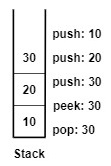Implement Stack using Queues | Stack Problem
4 years ago Lalit Bhagtani 0
Problem Statement
Design a Stack (LIFO) data structure using Queue (FIFO). The Stack data structure will supports the following operations:
- push(N) :- It insert element N onto the top of the stack.
- pop() :- It removes and returns the element from the top of the stack.
- peek() :- It returns (not remove) the element from the top of the stack.
- empty() :- It checks whether the stack is empty.
Note: Only standard operations of a queue are allowed like enqueue an element to back of a queue, dequeue or peek an element from the front of a queue and, empty operation.
Example

MyStack stack = new MyStack();
stack.push(10);
stack.push(20);
stack.push(30);
stack.peek(); // returns 30
stack.pop(); // returns 30
stack.empty(); // returns false
Solution
Two Queue (backed by linked list) data structure can be used to implement a Stack data structure. Implementation can be done in two different ways:
Push in O(1) And Pop & Peek in O(n) :
Each operation of the stack will work in the following way:
- push(N) :- It enqueue an element N to the back of queue A
- pop() :- If queue A is empty, then it dequeue n-1 (n is the size of queue B) elements from queue B and enqueue them to queue A and return the last element of queue B. If queue A is not empty, then it dequeue n-1 elements from queue A and enqueue them to queue B and returns the last element of queue A
- peek() :- If queue A is empty, then it dequeue all (save last element in temporary variable) elements from queue B and enqueue them to queue A and return the last element of queue B. If queue A is not empty, then it dequeue all elements from queue A and enqueue them to queue B and returns the last element of queue A.
- empty() :- It returns true if queue A and B are empty otherwise, it returns false.
Program
import java.util.LinkedList;
import java.util.Queue;
public class MyStack {
public static void main(String[] args) {
MyStack stack = new MyStack();
stack.push(10);
stack.push(20);
stack.push(30);
System.out.println("Peek: " + stack.peek());
System.out.println("Pop: " + stack.pop());
}
public Queue<Integer> queueA = null;
public Queue<Integer> queueB = null;
public MyStack() {
this.queueA = new LinkedList<>();
this.queueB = new LinkedList<>();
}
public void push(int x) {
queueA.add(x);
}
public int pop() {
if(queueA.size() == 0){
while(queueB.size() >1){
queueA.add(queueB.poll());
}
return queueB.poll();
}else {
while(queueA.size() >1){
queueB.add(queueA.poll());
}
return queueA.poll();
}
}
public int peek() {
if(queueA.size() == 0){
while(queueB.size() >1){
queueA.add(queueB.poll());
}
int value = queueB.peek();
queueA.add(queueB.poll());
return value;
}else {
while(queueA.size() >1){
queueB.add(queueA.poll());
}
int value = queueA.peek();
queueB.add(queueA.poll());
return value;
}
}
public boolean empty() {
return (this.queueA.size() == 0 && this.queueB.size() == 0);
}
}
Push in O(n) And Pop & Peek in O(1) :
Each operation of the stack will work in the following way:
- push(N) :- If queue A is empty, then enqueue an element N to A and dequeue all elements from queue B and enqueue them to queue A. Otherwise if queue B is empty, then enqueue an element N to B and dequeue all elements from A and enqueue them to queue B.
- pop() :- If queue A is empty, then dequeue and return the element from queue B and If queue B is empty, then dequeue and return the element from queue A
- peek() :- If queue A is empty, then peek and return the element from queue B and If queue B is empty, then peek and return the element from queue A
- empty() :- It returns true if queue A and B are empty otherwise, it returns false.
Program
import java.util.LinkedList;
import java.util.Queue;
public class MyStack {
public static void main(String[] args) {
MyStack stack = new MyStack();
stack.push(10);
stack.push(20);
stack.push(30);
System.out.println("Peek: " + stack.peek());
System.out.println("Pop: " + stack.pop());
}
public Queue<Integer> queueA = null;
public Queue<Integer> queueB = null;
public MyStack() {
this.queueA = new LinkedList<>();
this.queueB = new LinkedList<>();
}
public void push(int x) {
if(queueA.size() == 0){
queueA.add(x);
while(queueB.size() >0){
queueA.add(queueB.poll());
}
}else {
queueB.add(x);
while(queueA.size() >0){
queueB.add(queueA.poll());
}
}
}
public int pop() {
if(queueB.size() == 0){
return queueA.poll();
} else {
return queueB.poll();
}
}
public int peek() {
if(queueB.size() == 0){
return queueA.peek();
} else {
return queueB.peek();
}
}
public boolean empty() {
return (this.queueA.size() == 0 && this.queueB.size() == 0);
}
}
Result
Peek: 30
Pop: 30
Similar Post
That’s all for Implement Stack using Queues in Java, If you liked it, please share your thoughts in a comments section and share it with others too.
